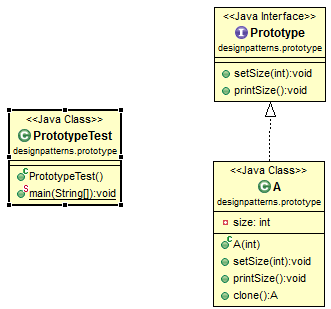Prototype design pattern is used when very similar objects are frequently created. Prototype pattern clones objects and set the changed feature. In this way, less resources are consumed.
1. Prototype Pattern Class Diagram
2. Prototype Pattern Java Example
package designpatterns.prototype; //prototype interface Prototype { void setSize(int x); void printSize(); } // a concrete class class A implements Prototype, Cloneable { private int size; public A(int x) { this.size = x; } @Override public void setSize(int x) { this.size = x; } @Override public void printSize() { System.out.println("Size: " + size); } @Override public A clone() throws CloneNotSupportedException { return (A) super.clone(); } } //when we need a large number of similar objects public class PrototypeTest { public static void main(String args[]) throws CloneNotSupportedException { A a = new A(1); for (int i = 2; i < 10; i++) { Prototype temp = a.clone(); temp.setSize(i); temp.printSize(); } } } |
3. Prototype Design Pattern Used in Java Standard Library
java.lang.Object – clone()

http://www.roytuts.com/prototype-pattern-in-jee-design-pattern/
sorry why less resources are consumed?
You could also make clone() to accept “int size”, so that a newly cloned object would already have its size set upon return.
Less code in caller methods. 🙂